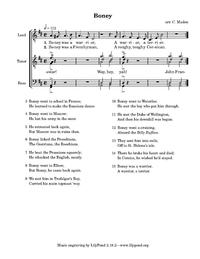Difference between revisions of "Boney"
| (2 intermediate revisions by the same user not shown) | |||
| Line 13: | Line 13: | ||
“[[Boney]]” is track 6 on ''[[Shower Chanteys]]'', recorded 18 July 2018 at [[Mill Pond Music Studio]].<ref>“Boney,” recording by Chris Maden. [https://musicbrainz.org/recording/ffd81410-ca40-4653-a3a4-8deadca2c04f MusicBrainz].</ref> | “[[Boney]]” is track 6 on ''[[Shower Chanteys]]'', recorded 18 July 2018 at [[Mill Pond Music Studio]].<ref>“Boney,” recording by Chris Maden. [https://musicbrainz.org/recording/ffd81410-ca40-4653-a3a4-8deadca2c04f MusicBrainz].</ref> | ||
| − | “Boney” is a single-pull or short-drag chantey. | + | “Boney” is a single-pull or short-drag chantey; Hugill also gives it as a halyard chantey,<ref>Stan Hugill. ''Shanties from the Seven Seas'', pp. 333–335. New U.S. Edition. Mystic, Conn.: Mystic Seaport, 1994.</ref> and Colcord also gives it as a sweating-up chantey.<ref>Joanna C. Colcord. ''Songs of American Sailormen'', pp. 40–41. Enlarged and Revised Edition. New York: Bramhall House, 1938.</ref> I’m a little skeptical of that last, as sweating up—taking the slack out of lines—rarely takes more than a few pulls, and a chantey that tells a story is never going to get anywhere. |
| + | I first heard it at the [https://www.nps.gov/safr/learn/historyculture/chantey-sing.htm San Francisco chantey sing], though there have been lots of other influences. Often at chantey sings, you’ll hear the lead wait for the response to finish; I like this overlapping version better. I really like to use it at [https://www.mysticseaport.org/ Mystic Seaport] for hauling a whaleboat up the side of the ''Charles W. Morgan''; one of the first things I learned at Mystic is that a chanteyman generally doesn’t sing the responses, because there’s just not enough air! I usually introduce it as, “This is a true story<ref>Chris Maden. “Double-header! (pt. 2),” [https://www.kickstarter.com/projects/crism/shower-chanteys/posts/2244233 Kickstarter update.] 21 July 2018.</ref> about a guy named ‘Boney’ who tried to take over Europe.” Someone on the demo squad told me that he hadn’t realized what the song was actually about before then. | ||
| − | + | It’s also fun that this chantey is fairly historically accurate, aside from the usual sailors’ mispronunciations (“Billy Ruffian” for ''Bellerophon'', the ship that took Napoleon into exile, for example). Some other versions include references to his being poisoned.<ref>Glenn Grasso, ed. ''Songs of the Sailor'', p. 38. Mystic, Conn.: Mystic Seaport, 1998.</ref> | |
| − | + | Smith also mentions this chantey, though her treatments makes me wonder… she gives one version, with no verses, and the “John Franswar” response,<ref name="smith37">Laura Alexandrine Smith. ''The Music of the Waters'', p. 37. London: Kegan Paul, Trench & Co., 1888.</ref>, and then another with the first “Boney” verse but no others, and a completely different response.<ref name="smith37"/> Later, she gives the more conventional verses, but only responses of “Way, hay, yah!”<ref>Laura Alexandrine Smith. ''The Music of the Waters'', pp. 53–54. London: Kegan Paul, Trench & Co., 1888.</ref> A footnote on that one wonders, “Where is ‘Elbow’?” | |
| − | |||
| − | |||
== References == | == References == | ||
| Line 28: | Line 27: | ||
[[Category:Shower Chanteys]] | [[Category:Shower Chanteys]] | ||
[[Category:Halyard chanteys]] | [[Category:Halyard chanteys]] | ||
| + | [[Category:Single-pull chanteys]] | ||
| + | [[Category:Sweating-up chanteys]] | ||
Latest revision as of 19:12, 11 October 2018

“Boney” is a sea chantey.
Alternate names
- Boney Was a Warrior
External links
- “Boney” at The Digital Tradition on the Mudcat Café
- “Boney” discussion on the Mudcat Café
- “Boney” at MusicBrainz
Liner Notes
“Boney” is track 6 on Shower Chanteys, recorded 18 July 2018 at Mill Pond Music Studio.[1]
“Boney” is a single-pull or short-drag chantey; Hugill also gives it as a halyard chantey,[2] and Colcord also gives it as a sweating-up chantey.[3] I’m a little skeptical of that last, as sweating up—taking the slack out of lines—rarely takes more than a few pulls, and a chantey that tells a story is never going to get anywhere.
I first heard it at the San Francisco chantey sing, though there have been lots of other influences. Often at chantey sings, you’ll hear the lead wait for the response to finish; I like this overlapping version better. I really like to use it at Mystic Seaport for hauling a whaleboat up the side of the Charles W. Morgan; one of the first things I learned at Mystic is that a chanteyman generally doesn’t sing the responses, because there’s just not enough air! I usually introduce it as, “This is a true story[4] about a guy named ‘Boney’ who tried to take over Europe.” Someone on the demo squad told me that he hadn’t realized what the song was actually about before then.
It’s also fun that this chantey is fairly historically accurate, aside from the usual sailors’ mispronunciations (“Billy Ruffian” for Bellerophon, the ship that took Napoleon into exile, for example). Some other versions include references to his being poisoned.[5]
Smith also mentions this chantey, though her treatments makes me wonder… she gives one version, with no verses, and the “John Franswar” response,[6], and then another with the first “Boney” verse but no others, and a completely different response.[6] Later, she gives the more conventional verses, but only responses of “Way, hay, yah!”[7] A footnote on that one wonders, “Where is ‘Elbow’?”
References
- ↑ “Boney,” recording by Chris Maden. MusicBrainz.
- ↑ Stan Hugill. Shanties from the Seven Seas, pp. 333–335. New U.S. Edition. Mystic, Conn.: Mystic Seaport, 1994.
- ↑ Joanna C. Colcord. Songs of American Sailormen, pp. 40–41. Enlarged and Revised Edition. New York: Bramhall House, 1938.
- ↑ Chris Maden. “Double-header! (pt. 2),” Kickstarter update. 21 July 2018.
- ↑ Glenn Grasso, ed. Songs of the Sailor, p. 38. Mystic, Conn.: Mystic Seaport, 1998.
- ↑ 6.0 6.1 Laura Alexandrine Smith. The Music of the Waters, p. 37. London: Kegan Paul, Trench & Co., 1888.
- ↑ Laura Alexandrine Smith. The Music of the Waters, pp. 53–54. London: Kegan Paul, Trench & Co., 1888.